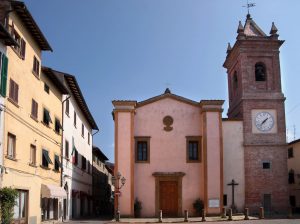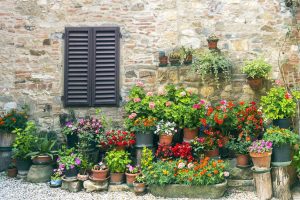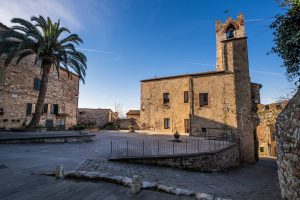
©Bigstock.com/cmfotoworks
A stroll through Tuscany takes you from imposing mountain ridges to wide rolling hills and flat plains right by the sea. This variety of landscapes is set against a backdrop of equally diverse nature, the region’s marvellous cuisine and captivating cultural attractions. One such journey across Tuscany, from east to west, is on the itinerary today. We introduce you to some of the most beautiful places in Italy of the private association “I borghi più belli d’Italia” in the Metropolitan City of Florence and in the Provinces of Livorno and Pisa that neatly highlight the quieter yet beautiful aspects of the region.
Metropolitan City of Florence
This time we start in the north-east where the Metropolitan City of Florence borders on Emilia Romagna. Of course, you know the region primarily because of its capital: Florence with its historic centre, a designated UNESCO World Heritage Site, is one of the most beautiful and important cities of art and culture in the country, even throughout Europe. The most beautiful places in the Metropolitan City of Florence, on the other hand, show you that something special extends across the entire region.
Montaione
The Middle Ages left their mark on Montaione (approx. 3,600 inhabitants). The village was once a huge oval castle complex, surrounded by thick walls with eleven towers and two gates. Even though many of these structures disappeared after the Second World War, the historical structures have been preserved and harmonise wonderfully with modern street planning. Montaione offers marvellous views and even more magnificent buildings. The town’s many churches and monasteries as well as countless castles invite you on a journey through its illustrious history, crowned by a visit to the archaeological museum Museo Civico di Montaione, which reopened in 2002. There is even a Roman cistern from the 2nd century BC to admire. You should also not miss the Convento di San Vivaldo with its Jerusalem complex consisting of 18 chapels.

©Bigstock.com/Claudiogiovanni
Montefioralle
This part of the municipality of Greve in Chianti has one of the best-preserved fortifications in the region. Montefioralle (approx. 100 inhabitants) and its castle first documented mention was in 1085. Some houses were even built into the old castle towers. Moreover, the noble Vespucci family once resided here, although the theory that Amerigo Vespucci was born in Montefioralle has been all but disproved. There is plenty to discover on the long circular route through the village even beyond nobility. The centrepiece is the Romanesque Chiesa di Santo Stefano, full of impressive works of art, some of which date back to the 13th century.
Palazzo sul Senio
Few places manage to blend nature and architecture as excellently as Palazzo sul Senio (approx. 1,100 inhabitants) in the Apennines. The densely wooded area fascinatingly integrates the bright greenery and lush vegetation into the townscape. The 17th century Chiesa dei Santi Carlo e Antonio, for example, was built directly into the green hills of the village. You can experience the origins of Palazzo sul Senio in the Chiesa di Santo Stefano. Although the church was remodelled several times in later times, its 9th century roots remain tangible. On your tour through the town, divided by a river, you will inevitably pass the Palazzo dei Capitani, where Pope Julius II and Niccolò Machiavelli once stayed. Today, the palace houses two museums dedicated to the history and culture of the region.
San Donato in Poggio
One of Italy’s newer most beautiful places is actually part of the municipality of Barberino Tavarnelle, but has a long and illustrious history of its own. The first documented mention of San Donato in Poggio (approx. 1,000 inhabitants) can be tracked back to 989 – in connection with the imposing Romanesque Pieve di San Donato in Poggio which, among other things, houses a triptych from 1375 and a baptismal font dating from around 1513. Some of its earlier paintings are currently exhibited in the Museo Diocesano di Santo Stefano al Ponte in Florence. Other churches, palaces and shrines, including the ornate Santuario di Santa Maria delle Grazie a Pietracupa, located just outside the village, await you in San Donato in Poggio. Immerse yourself in the world of astronomy with events and guided tours at the Osservatorio Polifunzionale del Chianti, surrounded by an impressive botanical garden.
Scarperia e San Piero
This former outpost of the Republic of Florence, created in 2014 by the merger of the municipalities of San Piero a Sieve and Scarperia, is home to the Autodromo Internazionale del Mugello racetrack, where the Italian Grand Prix of the Motorcycle World Championship is held every year. Knives and coffee machines are also manufactured in Scarperia e San Piero (population approx. 7,100). All of this takes place in the heart of what at first glance appears to be a sleepy town that is actually rich in medieval churches and palaces. Many were repeatedly restored and rebuilt after severe earthquakes in 1542 and 1929, including the Prepositura dei Santi Jacopo e Filippo with its rich furnishings and magnificent paintings, and the inconspicuous Cappella della Madonna di Piazza with its late Gothic tabernacle.
Province of Livorno
From the hinterland we head towards the sea: the Province of Livorno attracts visitors from all over the country, in fact from all over the world. Cecina and Piombino not only stand out with their beaches, and the city of arts Livorno with its fortresses provides fascinating insights into days long gone. The latter also applies to the three most beautiful places in the Province of Livorno which are already waiting for you.
Campiglia Marittima
The vast municipality of Campiglia Marittima covers an area of 83 km² and extends from the Montroni Nature Park to the foothills of the Etruscan Riviera. While you can experience almost the entire range of the Province of Livorno here, we focus on the main village (approx. 380 inhabitants) with its medieval centre on a hill and steep alleyways leading through a wonderfully original village with raw façades and winding corridors. The majestic Romanesque Pieve di San Giovanni with its Sator square is characterised by its simple, clear forms. 72 coats of arms adorn the Palazzo Pretorio, now home to museums and archives, while the Rocca with its museum illustrates the development of the complex and the town. Remains of a farming settlement from the 10th century were discovered during excavations.
Populonia
We briefly mentioned Piombino earlier. Its Frazione Populonia (population approx. 17) is without doubt one of the smallest and most beautiful places in Italy. Once the only coastal town of the Etruscans, it was the largest ancient centre for iron processing in the Mediterranean. Traces of the Romans and Etruscans await you in the huge archaeological park, including the acropolis, various workshops and blast furnaces, as well as the necropolises. In Populonia Alta, which is still inhabited today, you can stroll through medieval squares with the fascinating Santa Maria della Croce including early 16th century frescoes. Only very few places bring together the region’s thousands of years of history quite as neatly.

©Bigstock.com/Roberto Nencini
Suvereto
While many places took deliberate steps to preserve their old townscape, it more or less happened automatically in Suvereto. The town was almost completely left to its own devices in the 17th and 18th centuries and almost died out due to wars, conflicts and poor air quality. Although around 3,200 inhabitants live in Suvereto today, it is a far cry from its glory days in the Middle Ages when, as a famous example, the body of Emperor Henry VII was saved from decomposition in the town and kept there for two years until the completion of Pisa Cathedral. Street names and the annual Palio are among the things commemorating this period. The ruins of the Rocca Aldobrandesca above the historic centre are a reminder of the former Pisan rule. Look forward to experience architectural gems galore, such as the beautiful cloister in the dissolved monastery of San Francesco and the magical loggia at the Palazzo Comunale town hall.
Province of Pisa
The Province of Pisa concludes this journey with the eponymous city of art of course known worldwide for its vertical challenged tower and gripping UNESCO World Heritage Site. In fact, the elongated province, which even borders the sea to the north, has a few other hidden treasures. The two most beautiful places in the Province of Pisa are already waiting for you.
Casale Marittimo
As in so many other beautiful places, Casale Marittimo (approx. 1,000 inhabitants) is steeped in history. Remains of Etruscan and Roman settlements were discovered during excavations. You can admire some of those finds in several places, such as the archaeological museum in Florence. However, the actual town centre is of medieval origin. Two town gates and various sections of wall remain from the long since demolished castle complex. They have been incorporated into the wider development of the town. The Chiesa di Sant’Andrea, on the other hand, is more recent, even if you wouldn’t necessarily realise from merely looking at it. It was built in 1873 over churches from the Middle Ages that had been destroyed in an earthquake two years earlier, using materials from their ruins. The frescoes depicting scenes from the life of Saint Andrew, on the other hand, were created in the 1980s.
Montescudaio
The eventful history of Montescudaio (approx. 1,800 inhabitants) began in the Iron Age, when the Villanova culture (and later the Etruscans) left their first traces on the hill of the village, which later became home to a Benedictine monastery. Dominated by Pisa and Florence, among others, two severe earthquakes in the 19th century destroyed large parts of the municipality, including the aforementioned monastery and the medieval castle complex. However, old walls and the typical street layout are still a reminder of its origins. With the imposing Torre Civica, the lower part of which was built in the 12th century, you will find further “witnesses” of that era. Santa Maria Assunta, the parish church rebuilt after the earthquakes, lures you inside with an 18th century marble statue and a Venetian-influenced painting of the Annunciation. The view from the church square on a clear day is breathtaking.
Tuscany has seen a comparatively large increase in the number of beautiful new places in recent years, especially in these three provinces, and that is more than understandable. The metropolitan City of Florence, the Province of Livorno and the Province of Pisa certainly stand out due to their imposing capitals, yet they also offer an abundance of historical spots in the hinterland that form an unrivalled symbiosis with the similarly diverse Tuscan nature. Experience one of Italy’s most famous regions from a welcome different angle!